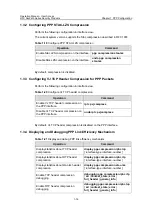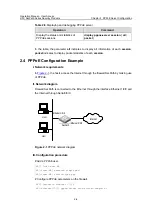
Operation Manual – User Access
H3C SecPath Series Security Products
Chapter 3 PPPoE Client Configuration
3-1
Chapter 3 PPPoE Client Configuration
3.1 Introduction to PPPoE Client
I. Overview
PPPoE is the abbreviation for Point-to-Point Protocol over Ethernet. It connects an
Ethernet host to a remote access concentrator via a simple bridging device. Through
PPPoE, a remote access device can realize control and accounting over each
accessing user. Compared with traditional access method, PPPoE has higher
performance-price ratio and is therefore widely assumed in applications like community
networking. It is also adopted in the currently popular broadband access mode ADSL.
PPPoE employs a client/server mode, in which it encapsulates PPP packets into
Ethernet frames to provide point-to-point connections over the Ethernet.
PPPoE has two different phases: Discovery phase and PPP Session phase.
z
Discovery phase
To initiate a PPP session, a host must first enter the Discovery phase to acknowledge
the peer's Ethernet MAC address and create a PPPoE Session ID. Whereas PPP
establishes a peer correlation, PPPoE however establishes a client/server correlation
in the Discovery phase. During the Discovery phase, a host (client) can discover an
access concentrator (server). After the Discovery phase, the host and the concentrator
can establish PPPoE session via the MAC address and session ID.
z
PPP Session phase
At the beginning of the PPP Session phase, the host and access concentrator transmit
PPP data and perform various PPP negotiations and data transfer over PPP. PPP
packets, as the payload of PPPoE frames, are encapsulated into Ethernet frames and
sent to the peer of a PPPoE link. In this case, all Ethernet frames are transmitted by
unicast.
For more information about PPPoE, refer to RFC2516.
II. Introduction to the PPPoE client
PPPoE is widely used in ADSL broadband access applications. Generally speaking, a
host must be installed with PPPoE client dialing software in order to access the Internet
via ADSL. SecPath series firewalls perform the PPPoE client function (namely the
PPPoE client dialing function), by which the user can access the Internet without
installing any client dialing software on his PC. Moreover, all PCs on the same LAN can
share the same ADSL account.



































